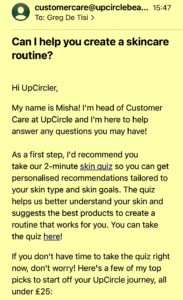
33 Tips To Understanding Discounts and Offers In Your Small Business
Why discount at all you may ask?
Well, its not a bad question, as sometimes it pays ‘not ‘to discount.
Allow me to explain: Whilst it may seem like a great idea to reduce prices to increase sales, and in many cases it is what customers look for these days, it can destroy your business.
So I have added some tips below to help you make the right decisions around your strategy.
We all know that many of us these days are now tightening our pockets as we are becoming more and more savvy with saving money and looking for great deals.
Myself included (smiling gladly!).
So, as sellers we also have to know the mindset of our customers by understanding Discounts and Offers.
But you can get this very wrong if you are not careful. Therefore I will share the techniques and strategies I have used with the greatest impact to help you get this right.
NOTE: We have all seen SALE signs, usually in red, and for good reason, it has great impact and draws us in.

Whilst using discounts is proven to work, and can drive more sales that can add new customers, and bring in those unsure, thus increasing profits, it has to be applied correctly.
‘All of us want to feel important, appreciated and that we matter, and so this is a key subject to be aware of when selling’!
You have to be smart when applying discounts so that your revenue isn’t destroyed, but your customer is happy.
Why do we need to be smart?
because we lose money, customers, sales and revenue if this is not correctly applied and implemented.
So the margin lost through discounting still needs to be met in the future, thus you will need to sell greater volume to make up for overall revenue you will lose.
NOTE: If you have a 30% margin, and you give a 10% discount, you have to sell 50% more business to make the same profits.
For a start, you need to know if your offers are aimed at existing customers or new customers, because if you are focused on new custom, you can craft very specific offers to drive new custom, even if there are losses in the process. and the more experienced you are the more you will know how much to offer or give away.
If an offer is crafted right it is designed to turn new customers into loyal and repeat customers, so in other words for some upfront costs, you can potentially create a customer for many years, so it is worth the effort, and as you form that relationship where the customer associates you and your brand with being connected to them you can feel all warm and fuzzy.
NOTE: Look at how it says ‘UP TO’ which means that ‘not all goods’ will be discounted as heavily % wise necessarily, but it does mean that potential customers are likely to click through to the offer, as they see the number shown. That is using business psychology.

I’m sure you know of brands you trust most, and sometimes even they can make mistakes, but they may not need to create many offers as their positioning is such that they have a high volume of life long customers buying at premium prices.
You will have seen many online shopping e-commerce sites that do offer 10% off, even 50% off, even before you add your email. and when you add your email it may become an even more tasty offer, because it is in our interest as business owners to collect as many details as we can get, and that’s because this is valuable data, as the more we know our customer the more refined we can be in our segmented marketing and the more we can accumulate a growing loyal customer fanbase.
So, I am sure you know that savvy sellers know that selling to you through their custom email series is worth giving a discount for if necessary.
They want your data, and they want to keep sending personalized offers and value your way.
But you knew that right!
Remember that you need to start Understanding Discounts and Offers through knowing your exact objective in all that you do.
Therefore you must create the right kind of copy, which of course can now be crafted by using AI technology, and you must ensure that you target the particular segment who need to understand that this is a one of a kind or exclusive offer.
Why? It makes the crafted offer more specific and this can increase conversion rates. So get specific and personal ok!

NOTE: Saying ‘Limited Time Offer’ creates fear and scarcity, so often drives a person to buy.
Here’s Your 33 Tips To Understanding Discounts and Offers In Your Small Business
Remember to know the primary reason why you are discounting!
- If you want people to accept your discount, give them a reason to want in. (Perhaps you have a new product?)
- This means you give them an incentive to want in.
- Ensure you have an experienced marketer if you are not one that can create a marketing strategy that is specific to understanding the value of segmented audiences.
- Never assume that a blast to all customers is best practice. It is often about focusing on a particular type of customer and tailoring your offers.
- Ensure you keep track of timing and monitor and measure effectiveness of campaigns and keep adjusting and testing.
- Understand your segment of customers through knowing their journey, and focus efforts and resources there.
- Understand that discounts & offers aren’t always the best route to go down. I.e. Loyal customers may not expect it often.
- Perhaps you have ‘old stock’ that needs to be gone, so this is where you might discount stock to get rid of stuff.
- Don’t be too pushy to new eyes. Think of your own experience when first visiting a website or e-commerce store.
- Start with gathering email. And if you can gather further information. Then you can engage deeper to increase offers.
- Ensure you have cookies enabled so you get visitors back, and craft a separate marketing goal to new customers. Also be sure to use re-targeting. Essentially this is online targeted advertising where advertising targets consumers based on their previous internet behavior. What’s the difference between re-targeting and re-marketing? Re-targeting aims to bring in new eyes and customers by using ads on social media, through email or on other sites, whereas remarketing tends to aim at selling and or marketing in order to ‘re-connect with past customers who have already engaged with your brand’.
- Be personal to ensure you craft copy that focuses only on the specific segment. And help them to feel exclusive.
- Show new customers ‘why’ you are offering discounts upfront. Make them feel special as they are new, welcome them.
- Think of perceived value. This means offering stuff that is not always about discounts. Example might be: a FREE tips on XYZ PDF. Or a guide to XYZ. This delivers value, and yet it doesn’t need to cost you a lot of money.
- With more loyal customers of consumers be sure to offer the right rewards to value them by investing in them.
- The biggest spenders should be valued with the right discounts and offers to help them stay loyal.
- Remember, people want to feel cared for. We all do! This means being personal with the relationship and rewards.
- In my local restaurant I collect loyalty points on my black card. That means money off future purchases, so I return.
- You may offer something other than money off products and services such as free post for a spend of over £100.
- Do you launch products? You could offer discounts as first customers, this will create high volumes of new custom.
- Special occasions, you might offer tips, ideas, suggestions etc, which cost you very little to share, yet offer value.
- Share product recommendations in your ideas and tips, to show what your customer needs to enhance their occasion.
- Have you heard of using scarcity? Study emails you have received about ‘time running out’, ‘missing out’, ‘Act quick’ etc.
- Don’t be too generous on all offers. Savvy consumers these days may look at something too cheap as poor quality.
- Always test what you start. That’s the best way to learn, but also from competition. Study them and absorb ideas.
- Monitor those who leave a purchase cart half way through. This could be due to further costs, or fear of spending.
- As you monitor cart leavers, think of what to offer as a sweetener to come back. The same for email subscribers. Before they unsubscribe offer something to keep the investment.
- Heard of Affiliates or referrals? Reward those who share your business. Loyal happy customers are a great option.
- Referring taken further; reward those who have been referred to you for joining you. A little sweetener is enough.
- Customer retention is the key, so offer what helps them feel looked after. Perhaps you create spread costs using Klarna, offering spread costs with no interest, or reduced subscriptions that tie them into you. Think of keeping your customers for the long haul.
- Perhaps you could create a membership site using a platform such as Shopify, Membermouse or Wild Apricot to drive continuity and increase that customer retention whereby you can then continue to offer the right value and discounts.
- That is why you need to become familiar with UVP, which is the key difference you can have to competition, whereby your product or service offers a UNIQUE VALUE PROPOSITION, thus positioning you as the preferred option in the market place.
- You could offer free online or offline events to drive potential customers to your door. From there discount products at the front end. This way they are enticed in and you have added new customers to your database. Just be sure not to over-discount through desperation. That’s it for now, but you have plenty to be looking at improving in your overall strategy. Just be mindful of where and when to do so, and again – study high performing businesses and see how they implement their events and strategies. That is how to begin Understanding Discounts and Offers!
Now, how can this discounting implementation really affect profitability? CLICK HERE TO READ THE FABULOUS TGG ACCOUNTANTS EXPLANATION OF REVENUE PER SALE AND PRICING AND PROMOTIONS
So there you have it!
33 Tips To Understanding Discounts and Offers In Your Small Business

At this point, you may know WAY more than your competition, but you also know that it means very little unless you implement it.
Do what you will need to do into your overall strategy, and you will start seeing vastly improved results. And if you want further details in any tips I shared above then do let me know.
Here are some further resources you may find useful that I crafted just for you:
HOW TO MASTER AI IN YOUR MARKETING AND CONTENT STRATEGY
HOW TO UNDERSTAND YOUR CUSTOMER EXPERIENCE
I also recommend these final tips:
- Look at what you buy, where you buy it and why you buy it. What about it do you trust?
- Look at where you subscribe with your email and why you do so. What made you connect and engage with this company?
- Look at where you un-subscribed to certain emails and why you did so. What was it that made you leave?
- Look at the reasons why you are tempted by certain or specific discounts and offers and not others.
- Look at what you look for in products and services, why that matters to you so much, and why you are loyal to these.
- Look at the value you expect to receive and why.
- Look at your own marketing mix, message and products and services. Ask yourself, why should anyone buy from you compared to your competition? And what can you begin now to implement in your offers.
Here are two typical examples of offers I received personally from emails of those whom I buy from:
You can see below that H&M are offering me the possibility of earning £200 to invite friends to Klarna. And Klarna also offer me money to sign up new customers directly to them. Meaning = We will give you a great discount when you refer our friend.
The email from a Small company I love called UpCircle want me to take a quiz to help them improve their business, and are offering me a routine with my skincare. Meaning = Here is an offer, and could you help us to know you more.


I am sure you receive many emails, and see many offers, so study them and gain insight from those you receive, that is exactly what I do. And it’s not just those with mammoth budgets that have the best marketing strategies, many micro and small business owners are very creative and can gain vital trust through being so personal, generous and transparent. So, don’t assume that the more money spent means more impact, it doesn’t always, what matters most is learning, evolving, and getting better.
This means ensuring you understand your metrics and that they are specific measures tracking your business processes, otherwise you cannot monitor performance. Whilst we all have various metrics in different businesses you must master yours to ensure they quantifiable.
NOTE: Saying ‘Special Offer’ demonstrates that this is a unique and exclusive offer and can often be used for certain customers only.

Finally, be aware of how you use every word in your offers, and please don’t avoid the advice given if you value the long term growth of your small business model. You really don’t want to be hoping and preying that your tactics work all of the time ‘by chance’.
Use your resources focusing on your priorities and tasks whereby your team understand their roles, and each is a part of the overall plan to create measured progress in your strategies and tactics.
If you have any questions about this area, feel free to message me anytime. Oh and share the love if you enjoyed it.
The Best As Always – Greg
P.S. Don’t forget to give this a little tweet, as sharing is caring!
Understanding Discounts and Offers In Your Small Business Click To Tweet
-- Download 33 Tips To Understanding Discounts and Offers In Your Small Business as PDF --











